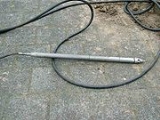
Moling
Encyclopedia
In the construction
industry, moling is a trenchless
method used to lay pipes
. During the moling process, a pneumatically-driven machine known as a mole forces its way through the soil
along the desired path of the pipe. Moling avoids the need to dig a trench
and can be used to lay water pipes and the heating coils of heat pump
systems.
Recently moles that are steerable have been developed allowing an operator to correct the track of the mole and to achieve curved bores.
 The standard approach to moling is to dig a hole about 1 m square and 2 m deep. Such a hole is small enough that it can be dug by hand instead of by machine in inaccessible locations. The mole is then entered into the earth on the horizontal face at the bottom of this hole. A destination hole of similar proportions is also dug, and this is where the mole emerges. The mole itself is a steel
The standard approach to moling is to dig a hole about 1 m square and 2 m deep. Such a hole is small enough that it can be dug by hand instead of by machine in inaccessible locations. The mole is then entered into the earth on the horizontal face at the bottom of this hole. A destination hole of similar proportions is also dug, and this is where the mole emerges. The mole itself is a steel
cylinder about 60 cm long and 6 cm in diameter. It works as a pneumatic cylinder
with pulsed compressed air causing the head of the mole to repeatedly hammer against the soil in front of the mole. Once the mole has passed through the earth the pipe can be pulled through the long horizontal hole.
Construction
In the fields of architecture and civil engineering, construction is a process that consists of the building or assembling of infrastructure. Far from being a single activity, large scale construction is a feat of human multitasking...
industry, moling is a trenchless
Trenchless
Trenchless technology is a type of subsurface construction work that requires few trenches or no continuous trenches. It is a rapidly growing sector of the construction and civil engineering industry...
method used to lay pipes
Pipe (material)
A pipe is a tubular section or hollow cylinder, usually but not necessarily of circular cross-section, used mainly to convey substances which can flow — liquids and gases , slurries, powders, masses of small solids...
. During the moling process, a pneumatically-driven machine known as a mole forces its way through the soil
Soil
Soil is a natural body consisting of layers of mineral constituents of variable thicknesses, which differ from the parent materials in their morphological, physical, chemical, and mineralogical characteristics...
along the desired path of the pipe. Moling avoids the need to dig a trench
Trench
A trench is a type of excavation or depression in the ground. Trenches are generally defined by being deeper than they are wide , and by being narrow compared to their length ....
and can be used to lay water pipes and the heating coils of heat pump
Heat pump
A heat pump is a machine or device that effectively "moves" thermal energy from one location called the "source," which is at a lower temperature, to another location called the "sink" or "heat sink", which is at a higher temperature. An air conditioner is a particular type of heat pump, but the...
systems.
Recently moles that are steerable have been developed allowing an operator to correct the track of the mole and to achieve curved bores.

Steel
Steel is an alloy that consists mostly of iron and has a carbon content between 0.2% and 2.1% by weight, depending on the grade. Carbon is the most common alloying material for iron, but various other alloying elements are used, such as manganese, chromium, vanadium, and tungsten...
cylinder about 60 cm long and 6 cm in diameter. It works as a pneumatic cylinder
Pneumatic cylinder
Pneumatic cylinders are mechanical devices which utilize the power of compressed gas to produce a force in a reciprocating linear motion....
with pulsed compressed air causing the head of the mole to repeatedly hammer against the soil in front of the mole. Once the mole has passed through the earth the pipe can be pulled through the long horizontal hole.

